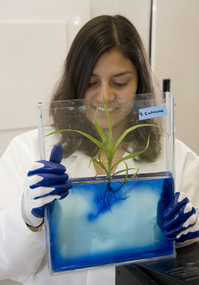 Research currently being conducted at the University of Minnesota, Crookston on wetland plants may provide important answers to solving one of our most pressing environmental challenges - the restoration of contaminated soil sediments.
Research currently being conducted at the University of Minnesota, Crookston on wetland plants may provide important answers to solving one of our most pressing environmental challenges - the restoration of contaminated soil sediments. Starting in February 2010, Assistant Professor of Environmental Sciences Katy Smith and recent university graduate Tamara Luna used a growth chamber in the lab to conduct tests on several plant species including Iris, Mimulus, Switchgrass, and Fescue. These were selected following an examination of the varying rates of radial oxygen loss, the rate at which wetland plants lose oxygen to the external environment.
"Some plants have high rates of radial oxygen loss and others are more efficient," Smith says. "We are interested in wetland plants and their effects of contaminants such as poly-aromatic hydrocarbons (PAHs) in the soil. Eventually, as contaminants move up the food chain, they reach humans and we store them in our body fat." The contaminants can occur naturally through events such as volcanic eruptions, but they are also produced in larger quantities through incomplete combustion so they are often associated with automobile exhaust and industrial waste, making their environmental impact significant.
The fact that these contaminants are toxic and carcinogenic makes the research both important and relevant to the field. Luna wrote her senior thesis in the honors program on her work with Smith. Early tests are still being evaluated and will become part of a body of scientific research in this area.
For now, the plants are cared for in the growth chamber and testing will begin again in earnest in February 2011. At that time, Smith and Kristin Werner, a senior horticulture major, will conduct a chemical analysis of the PAHs in the soils as well as three toxicity assays which
 will be used to determine the degree to which the toxicity of the sediments has been reduced by the presence of the plants. These toxicity assays include lettuce seed germination, an earthworm toxicity assay, and a rotifer toxicity assay. Lettuce and earthworms complete their lifecycle in the soil while rotifers are microscopic invertebrates that live in the water above the sediment.
will be used to determine the degree to which the toxicity of the sediments has been reduced by the presence of the plants. These toxicity assays include lettuce seed germination, an earthworm toxicity assay, and a rotifer toxicity assay. Lettuce and earthworms complete their lifecycle in the soil while rotifers are microscopic invertebrates that live in the water above the sediment.Bringing research into the classroom
Smith makes it a priority to bring her research into the classroom. "When students in botany study aerenchyma, the tiny air conduits that allow plants to live in a saturated environment, I bring my research directly to my students in the classroom," Smith says. "I am able to show them the value of studying the intricacy of plant life and some of the ways humans can impinge on our sensitive environment."
Smith's research interests mesh with the introduction of a new degree program on the Crookston campus this fall. With the addition of a bachelor's degree in environmental sciences, students will have an opportunity to study and address environmental issues, in areas such as, environmental ecology, water quality, agricultural environmental stewardship, environmental health, and environmental toxicology and chemistry. The program is interdisciplinary and includes coursework in the Math, Science, and Technology and the Agriculture and Natural Resources departments on the Crookston campus. Smith says she is excited about engaging students in a field with such relevance, importance, and global need.
For more information on the environmental sciences degree program, visit www.umcrookston.edu/academics.
Today the University of Minnesota, Crookston delivers 29 bachelor's degree programs, 17 minors, and more than 40 concentrations, including several online degrees, in the areas of agriculture and natural resources; business; liberal arts and education; and math, science and technology. With an enrollment of about 1,300 undergraduates from more than 25 countries and 40 states, the Crookston campus offers a supportive, close-knit atmosphere that leads to a prestigious University of Minnesota degree. "Small Campus. Big Degree." To learn more, visit www.umcrookston.edu.
In the photo, top left: Tamara Luna, '10, holds a glass observation box used for the methylene blue agar test.
In the photo, right: Luna (left) and Senior Kristin Werner (right) check on the plants in the growth chamber.
In the photo, right: Luna (left) and Senior Kristin Werner (right) check on the plants in the growth chamber.
Contact: Katy Smith, assistant professor, environmental sciences, 218-281-8262 (katys@umn.edu);Elizabeth Tollefson, assistant director, communications, 218-281-8432 (ltollefs@umn.edu)

